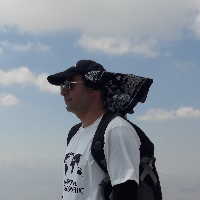Investigation of hydro geomorphological characteristics of the Latian basin by using SWAT model
Erosion of catchments and sediment load of rivers is one of the serious challenges of water resources management in the country, which has negative consequences in the operation of water facilities and dams. On the other hand, the amount of runoff, erosion and sediment transport varies depending on the hydrological conditions, soil and cover in the basin and this makes the simulation of the above processes need to provide the necessary information on how these factors change spatially (Jirani et al., 2011). Due to the diversity of the topography of the country, the majority of the watershed, especially in mountainous areas impassable, lack of gauging stations are sufficient and because the data these stations in different parts water resources management is used to simulate phenomena hydrology of the basin The optimal solution for this is data loss (Rostamian, 2006). Many models have been proposed for the description and forecast of the hydrology of the catchment, which is very different in terms of purpose, scale, time, and place (Sitgen et al., 2008).
SAWT is a physical model and instead of using regression equations to describe the relationship between input and output variables, it receives specific information about climate, soil, topography, vegetation, and land cover in the catchment. The physical processes related to water movement, sediment movement, plant growth, nutrient cycle in this model are simulated directly from the input parameters. The advantages of this method are that: 1- Basins without collected data (flow measurement information) can also be simulated. 2- The relative effect of input information (change in management methods, climate, and vegetation) on water quality and other variables can be quantified. The SWAT model uses easy and accessible input parameters and is very computationally efficient. Large and complex simulations, with different management strategies that can be implemented without spending a lot of time and money, enable the user to study the long-term effects. The subdivision is subdivided according to the characteristics of surface cover, land management, and soil characteristics. Calculations in the SWAT model to determine HRUs are performed using Equation (1) (Zahbiun et al., 2010). Equation (1): SWt = SW0 + – Qsurf – Ea – Wseep – Qgw) SWt = final amount of soil water (mm) SW0 = initial amount of soil water on the day I (mm) t = time (daily) Rday = Precipitation on the 1st day (mm) Qsurf = amount of surface runoff on the day I (mm) Ea = amount of evapotranspiration on the day I (mm) Wseep = amount of water entering from the unsaturated zone in soil profile on the day I (mm) Qgw = is the amount of return current on the day I (mm).
For Latian catchment, DEM with a spatial resolution of 12.5 m extracted from ALOS PALSAR satellite imagery, vector layer of land use, and soil texture of Lavasanat region with appropriate accuracy and Lavizan and Shimran synoptic stations were used. According to the land use map in the region, there are 4 different uses including rangeland, residential area, garden and lake, which due to the existence of two different soil classes in the region and three slope classes from 0 to 40, 40 to 60 and more than 60 degrees sub-basins and Hydrological response units were extracted in the area, which includes 34 sub-basins and 206 hydrological response units (HRU). According to the obtained model, the amount of surface runoff in the basin is equal to 67.06 mm and the amount of evapotranspiration in the desired catchment is equal to 117.7 mm and the average amount of sediment produced in the basin is equal to 1240.41 mg/ha and the maximum amount of sediment produced in the catchment is 3369.93 mg/ha, of which 1231.65 mg/ha is deposited downstream of the basin.
In this study, using the SWAT model, the hydrological characteristics of Latian catchment were investigated. Based on the results obtained in the region, there are 4 different uses including rangeland, residential area, garden, and lake, which due to the existence of two different soil classes in the region. And three slope classes of 0 to 40, 40 to 60 and more than 60 degrees of sub-basins and hydrological response units of the region were extracted, which include 34 sub-basins and 206 hydrological response units (HRU). After determining the hydrological response units of the basin using daily synoptic data, the CN value of the basin is 82.1, which according to the definition of CN means that out of 395.9 mm of annual rainfall, the soil of this basin is only able to absorb 17.9% and The rest of the precipitation on the surface is in the form of surface runoff and evapotranspiration, which is a relatively high amount. Infiltrates and makes the catchment flood-prone to occur, the construction of the Latian Dam downstream of the basin will control floods from above. According to the model results, the amount of surface runoff in the basin is 67.06 mm and the amount of evapotranspiration in the catchment is 117.7 mm. Also, the average amount of sediment produced in the basin is equal to 1240.41 mg/ha and the maximum amount of sediment produced in the catchment is 3369.93 mg/ha, of which 1231.65 mg/ha is deposited downstream of the basin, so water erosion and sediment production in Latian catchment This can have adverse effects on the Latian Dam. According to the obtained results and determining the average amount of runoff and sediment entering the dam, the dam conditions in sudden rains and prevented possible hazards.
- حق عضویت دریافتی صرف حمایت از نشریات عضو و نگهداری، تکمیل و توسعه مگیران میشود.
- پرداخت حق اشتراک و دانلود مقالات اجازه بازنشر آن در سایر رسانههای چاپی و دیجیتال را به کاربر نمیدهد.



